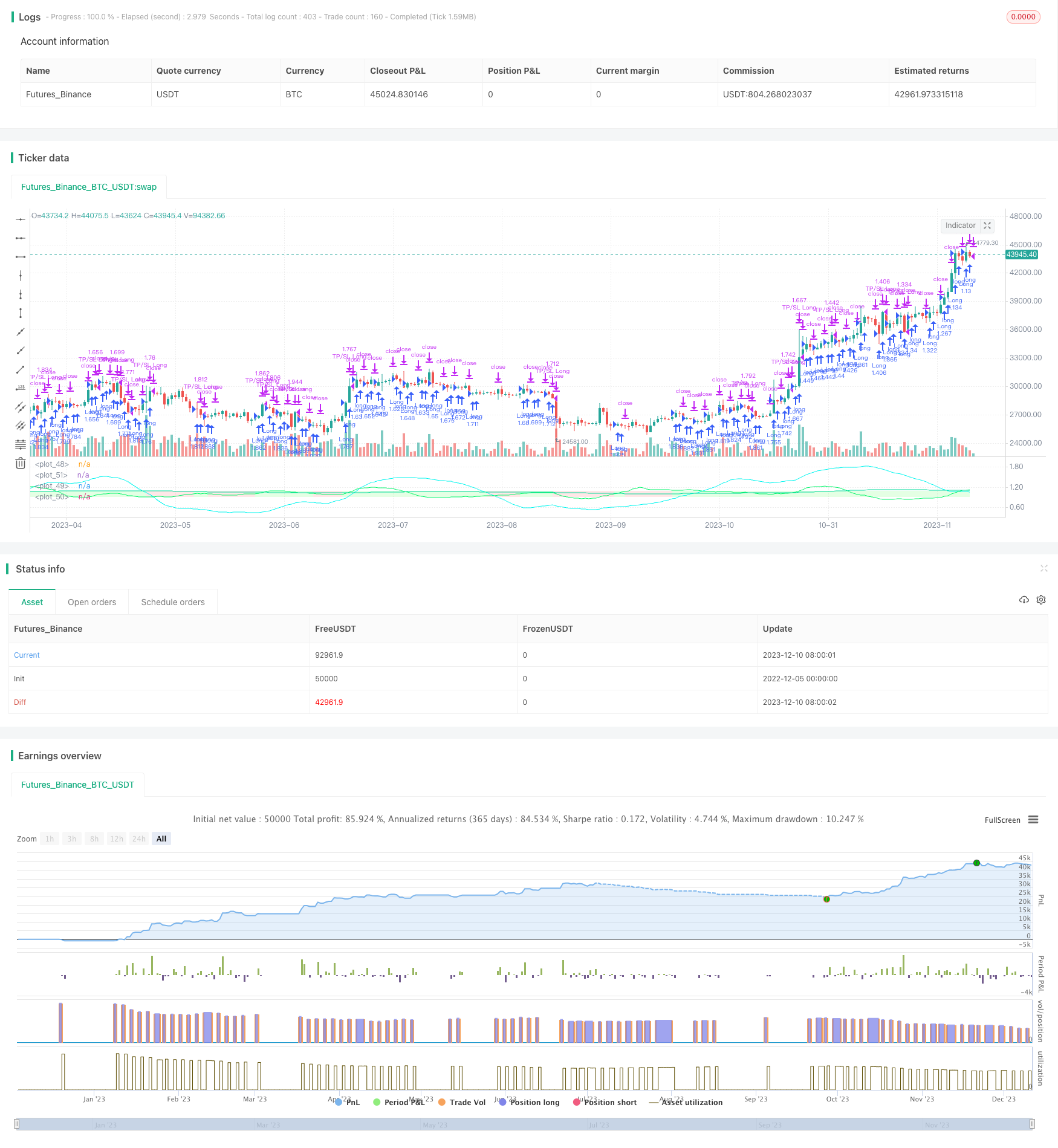
개요
이 전략은 역동적인 지표 RSI와 가격의 Exponential Moving Average (EMA) 와 Simple Moving Average (SMA) 를 기반으로 거래 신호를 구축합니다. 이것은 트렌드 추적 유형의 전략입니다.
전략 원칙
이 전략은 3가지 조건으로 거래 신호를 생성합니다.
- RSI > 45: RSI 값이 45 이상이면 좋은 구매 신호로 간주됩니다.
- EMA ((RSI) > SMA ((RSI): EMA 선이 SMA 선보다 크다는 것은 RSI가 상승 속도를 내고 있다는 것을 의미하며, 좋은 운동 신호입니다.
- EMA ((폐쇄 가격) > SMA ((폐쇄 가격): EMA 선이 SMA 선보다 크다는 것은 가격 추세가 가속화되고 있음을 나타냅니다.
위의 3가지 조건 중 임의의 2가지가 충족되면 구매 신호가 발생하고, 모두 충족되지 않으면 판매 신호가 발생한다.
이 전략은 동시에 항상 구매하는 모드를 제공하여 시스템 자체의 상대적인 대역의 성능을 테스트합니다.
전략적 강점 분석
- 동적 지표 RSI를 사용하여 시장 상황을 판단하여 시장의 흔들림 기간의 거래를 줄일 수 있습니다.
- EMA와 SMA의 추세 방향 판단과 결합하여 가격 변화의 동향을 적시에 잡을 수 있습니다.
- 조건 규칙은 간단하고 명확하며 이해하기 쉽고 최적화 가능합니다.
- 은 항상 구매할 수 있습니다.
전략적 위험 분석
- 매개 변수 설정에 따라, 매개 변수가 잘못되면 거래가 빈번하게 이루어지거나 좋은 거래 기회를 놓치게 됩니다.
- 큰 소식이 있을 때, 단기간에 큰 가격 변동이 발생할 수 있으며, 이로 인해 손실이 발생할 수 있습니다.
- 전략 자체로는 트렌드 반전의 시점을 판단할 수 없으며, 다른 지표와 함께 판단해야 합니다.
최적화 방향
- RSI, EMA 및 SMA의 변수를 최적화하여 최적의 변수 조합을 찾습니다.
- , MACD 등 다른 기술 지표 판단 규칙을 추가
- 트렌드 반전 판단 지수를 늘리고 손실 가능성을 낮추는 것
요약하다
이 전략은 전체적으로 중장기 가격 동향을 포착하고 단기 시장의 변동을 피하기 위한 중장기 거래 전략에 속한다. 이 전략의 장점과 위험점은 모두 분명하다. 매개 변수 최적화 및 규칙 풍부 함으로써 전략의 안정성을 더욱 강화할 수 있으며, 깊이 연구하고 최적화할 가치가 있는 고효율 수치화 거래 전략이다.
전략 소스 코드
/*backtest
start: 2022-12-05 00:00:00
end: 2023-12-11 00:00:00
period: 1d
basePeriod: 1h
exchanges: [{"eid":"Futures_Binance","currency":"BTC_USDT"}]
*/
//@version=5
strategy("I11L Unitrend",overlay=false, initial_capital=1000000,default_qty_value=1000000,default_qty_type=strategy.cash,commission_type=strategy.commission.percent,commission_value=0.00)
tradingMode = input.string("Unitrend", "Trading Mode", ["Unitrend", "Always Buy"], tooltip="Choose the Trading Mode by trying Both in your Backtesting. I use it if one is far better then the other one.")
compoundingMode = input.bool(false)
leverage = input.float(1.0,step=0.1)
SL_Factor = 1 - input.float(1,"Risk Capital per Trade unleveraged (%)", minval=0.1, maxval=100, step=0.1) / 100
TPFactor = input.float(2, step=0.1)
var disableAdditionalBuysThisDay = false
var lastTrade = time
if(time > lastTrade + 1000 * 60 * 60 * 8 or tradingMode == "Always Buy")
disableAdditionalBuysThisDay := false
if(strategy.position_size != strategy.position_size[1])
lastTrade := time
disableAdditionalBuysThisDay := true
//Trade Logic
SCORE = 0
//rsi momentum
RSIFast = ta.ema(ta.rsi(close,50),24)
RSISlow = ta.sma(ta.rsi(close,50),24)
RSIMomentum = RSIFast / RSISlow
goodRSIMomentum = RSIMomentum > 1
SCORE := goodRSIMomentum ? SCORE + 1 : SCORE
//rsi trend
RSITrend = RSISlow / 45
goodRSI = RSITrend > 1
SCORE := goodRSI ? SCORE + 1 : SCORE
//price trend
normalTrend = ta.ema(close,50) / ta.sma(close,50)
goodTrend = normalTrend > 1
SCORE := goodTrend ? SCORE + 1 : SCORE
isBuy = SCORE > 1 or tradingMode == "Always Buy"
isSell = false //SCORE == 0
//plot(SCORE, color=isBuy ? color.green : #ffffff88)
//reduced some of the values just for illustrative purposes, you can buy after the signal if the trendlines seem to grow
plot(1, color=isBuy ? #77ff7733 : SCORE == 2 ? #ffff0033 : SCORE == 1 ? #ff888833 : #ff000033,linewidth=10)
plot(1 - (1 - RSIMomentum) * 6,color=#00F569)
plot(1 - (1 - RSITrend) * 0.25,color=#00DB9B)
plot(1 - (1 - normalTrend) * 20,color=#00F5EE)
strategy.initial_capital = 50000
if(isBuy and not(disableAdditionalBuysThisDay))
if(compoundingMode)
strategy.entry("Long", strategy.long, (strategy.equity / close) * leverage)
else
strategy.entry("Long", strategy.long, (strategy.initial_capital / close) * leverage)
if(strategy.position_size != 0)
strategy.exit("TP/SL Long", "Long", stop=strategy.position_avg_price * (1 - (1 - SL_Factor)), limit=strategy.position_avg_price * (1 + (1 - SL_Factor) * TPFactor))